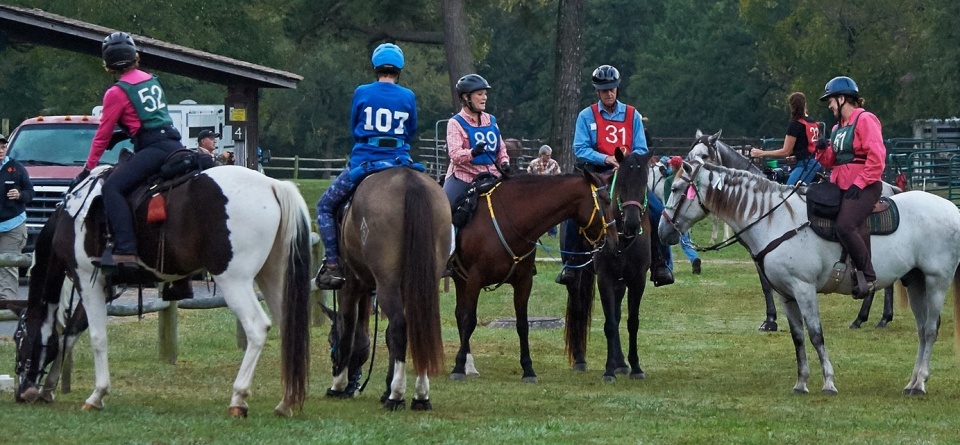By Bev Roberts
Photography by Optical Harmonics: Jim Edmondson and Mike Collins
Really? You bet! Now that you have made and executed your pre-ride strategy, it is time for the nitty gritty of your morning strategy before the ride starts. The goal – a calm, prepared horse and rider team and a controlled start.

In every plan, there are loads of controllable and uncontrollable things to consider. Some even impact what time you get up in the morning! Consider the forecasted weather, what went on during the night, feeding your horse, your tacking routine, your horse’s temperament, the speed s/he travels at a walk, the terrain, trail conditions, your temperament, the number of competitors in your division, and more.
Feeding strategy. For best performance, keep the feeding regimen as normal as possible. Because horses are naturally more active grazers at night, you will want to have more than enough hay for your horse to munch on overnight.
If using water-soaked beet pulp to help maintain your horse’s gut moisture during the ride, start serving it at home in the week before the ride. Feed it, and any other feeds like pellets, oats, etc., a couple of hours before ride start. It is easy to do this when you first wake up, before you even get dressed. Waiting to feed just before the ride start could result in your horse having higher than normal results at the first P&R. Think, in human terms, of you going for a jog immediately after gorging on Thanksgiving dinner!
Avoid anxiety. We all have our routines in the morning in getting ready for that day’s ride. However long your routine takes you, add an extra 10-15 minutes when setting your alarm the night before to allow for the unexpected. The unexpected could be a second potty trip, a horse that rolled during the night needing a grooming touchup, un-forecasted rain, your dog lazily taking care of business, and so on. A relaxed rider equals a quiet horse (usually).
To help keep you relaxed, have a checklist of what you will carry on the trail or have all those items out in one place so you remember to grab them all. Sample items are water, collapsible fan, electrolytes, hoof pick, pocket knife, gloves, map, helmet, lip balm, human and horse snacks, human medicine (if needed), cell phone, hankie, wad of toilet paper, GPS (Global Positioning System) device, spurs, first aid kit.

Know your horse. Is your horse cold backed or excitable versus one you can mount, ride up to the starting area and stand quietly waiting for your turn to start? Better to allow for, and take, a few minutes to lunge “old Dobbin” before mounting.
After you are in the saddle, execute a few pre-ride attitude adjustments – sidepassing, backing, turning – to assure that your horse is listening to you. Being the morning entertainment as a bronc rider is embarrassing! Also, it can affect your safety as well as others if the herd responds similarly.
Open riders usually travel at a trot with some walking to achieve, typically, a 5 mph or better, pace. If riding Open and you plan to start trotting within site of camp, consider warming up your horse’s muscles as you wait for your turn to start.
There are several strategies to engage if your horse is anxious to head out. Depending upon her/his degree of excitement, you can:
- face backward so your horse is looking at other horses and riders who are just standing around waiting to start.
- pick up a rein and turn your horse’s head.
- do a one rein stop.
- turn you horse in tight circles (like turns on the forehand) until when you release rein and leg pressure, your horse stops and stands quietly. Do this away from the other riders. Also, it helps to have worked on this behavior modification at home so your fire breathing dragon knows what you expect.
Chose where start in the group to best suit you and your horse. Open goes first. The Competitive Pleasure (CP)/Novice, who are sometimes intermixed, go next. With time, you will learn who likes to be up front (like to move out, have more go than whoa, or ride gaited horses); who likes last (slower horses, horses who do not buddy, or rider preference); and, who likes being in between (have calm, quiet horses accustomed to being passed). Knowing your horse allows you to select where to start.
Thinking, planning, and adjusting to changing conditions are all part of a successful and pleasurable competition.
_______________________________________________________
 Since 1961, we’ve helped riders of all ages learn the sport of competitive trail riding. Alongside other equine enthusiasts, you can deepen the relationship with your horse while learning new skills and setting your own competitive goals. There’s no place better to do this than on the open trail.
Since 1961, we’ve helped riders of all ages learn the sport of competitive trail riding. Alongside other equine enthusiasts, you can deepen the relationship with your horse while learning new skills and setting your own competitive goals. There’s no place better to do this than on the open trail.




